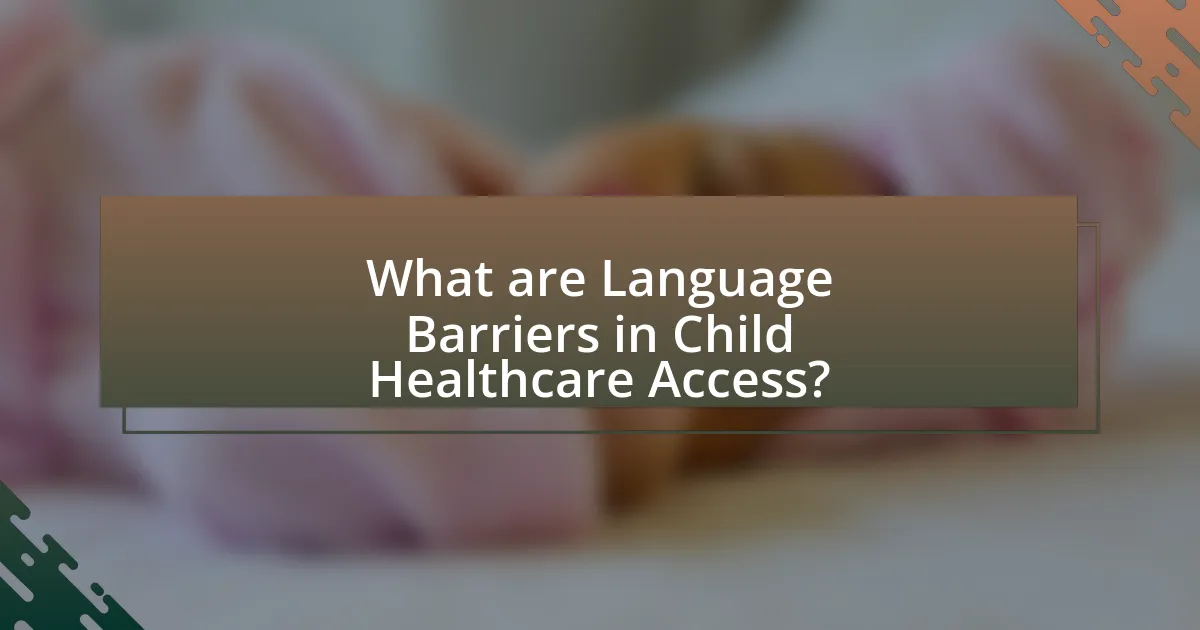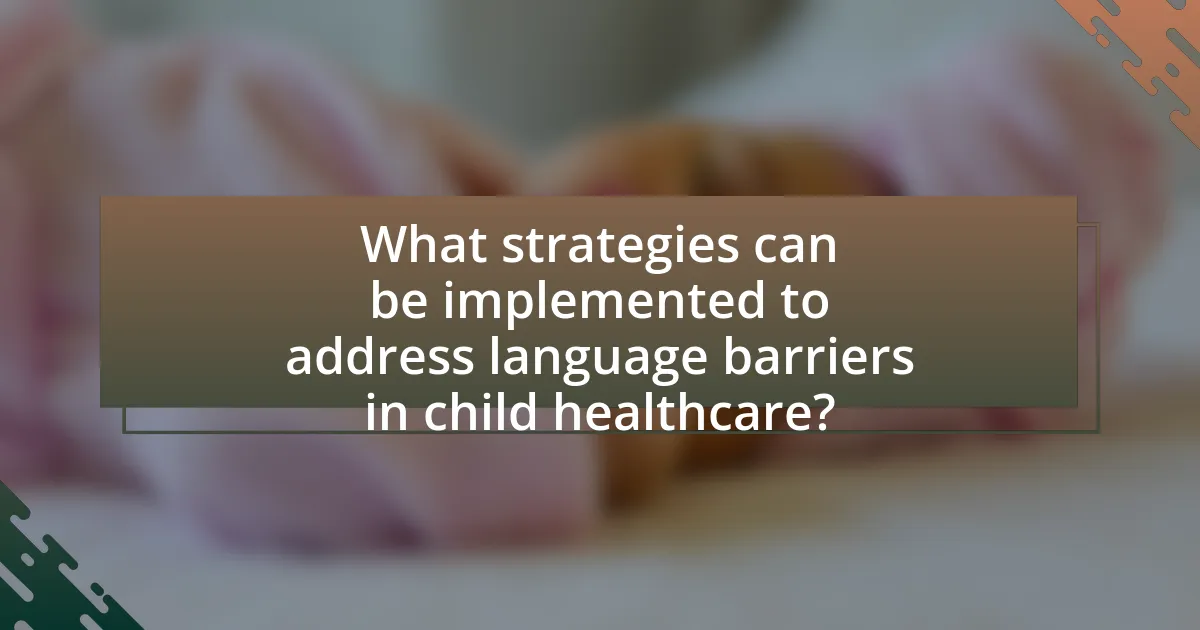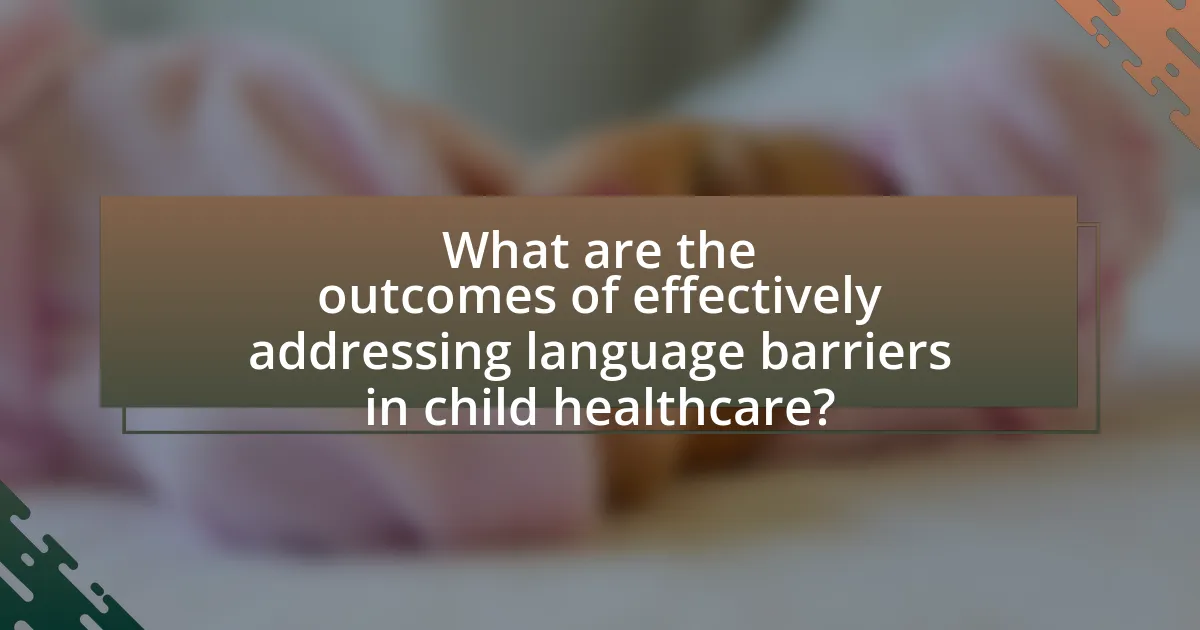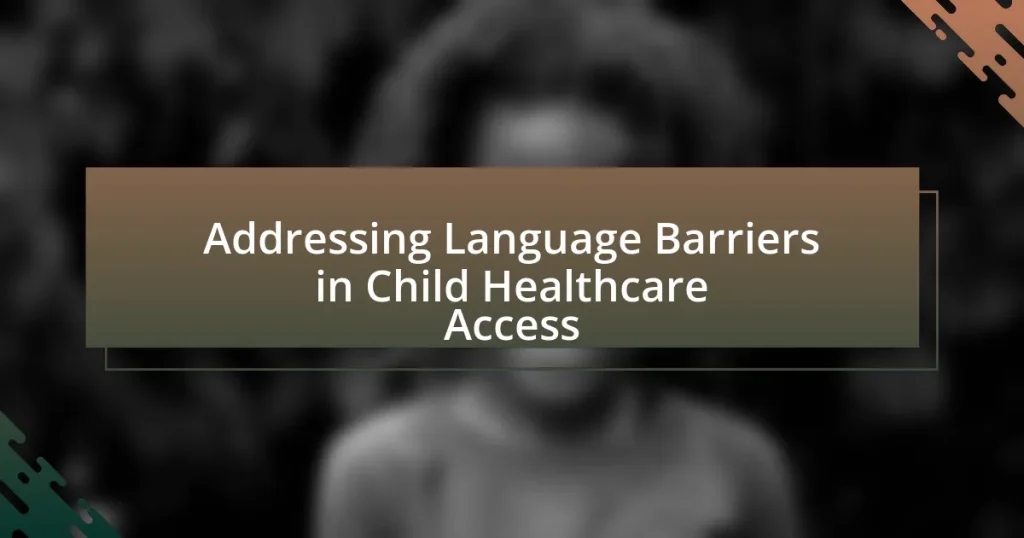Language barriers in child healthcare access refer to the challenges faced when healthcare providers and non-English speaking patients or their guardians cannot communicate effectively. These barriers can lead to misunderstandings about medical conditions, treatment plans, and medication instructions, ultimately compromising the quality of care for children. The article explores the impact of language barriers on healthcare access, the specific challenges faced by non-English speaking families, and the importance of addressing these barriers to improve health outcomes. It also discusses strategies for enhancing communication, such as employing bilingual staff and utilizing technology, as well as the role of community partnerships in facilitating better healthcare access for diverse populations.

What are Language Barriers in Child Healthcare Access?
Language barriers in child healthcare access refer to the difficulties that arise when healthcare providers and patients or their guardians do not share a common language, hindering effective communication. These barriers can lead to misunderstandings regarding medical conditions, treatment plans, and medication instructions, ultimately affecting the quality of care received by children. Research indicates that language barriers can result in increased hospital readmission rates and lower satisfaction with care, as families may struggle to convey symptoms or comprehend medical advice. For instance, a study published in the Journal of Health Care for the Poor and Underserved found that non-English speaking families are less likely to receive preventive care and more likely to experience adverse health outcomes.
How do language barriers impact healthcare for children?
Language barriers significantly hinder healthcare access and quality for children by impeding effective communication between healthcare providers and patients. When children and their caregivers cannot communicate their symptoms, medical history, or concerns due to language differences, it can lead to misdiagnoses, inappropriate treatments, and increased anxiety for both the child and the family. Research indicates that children from non-English speaking backgrounds are less likely to receive preventive care and more likely to experience delays in treatment, which can exacerbate health issues. A study published in the Journal of Health Care for the Poor and Underserved found that language barriers are associated with lower satisfaction rates and poorer health outcomes among pediatric patients.
What specific challenges do non-English speaking families face in accessing child healthcare?
Non-English speaking families face significant challenges in accessing child healthcare, primarily due to language barriers that hinder effective communication with healthcare providers. These barriers can lead to misunderstandings regarding medical instructions, diagnoses, and treatment plans, which can adversely affect the health outcomes of children. For instance, a study published in the Journal of Health Care for the Poor and Underserved found that limited English proficiency is associated with lower rates of preventive care and higher rates of hospitalizations among non-English speaking populations. Additionally, the lack of bilingual healthcare staff and translated materials exacerbates these challenges, making it difficult for families to navigate the healthcare system and advocate for their children’s needs.
How do language barriers affect communication between healthcare providers and patients?
Language barriers significantly hinder effective communication between healthcare providers and patients, leading to misunderstandings and inadequate care. When patients cannot communicate their symptoms or medical history accurately, healthcare providers may misdiagnose conditions or prescribe inappropriate treatments. A study published in the Journal of General Internal Medicine found that patients with limited English proficiency are more likely to experience adverse events due to communication failures. Additionally, language barriers can result in decreased patient satisfaction and lower adherence to treatment plans, as patients may feel frustrated or alienated in the healthcare setting.
Why is addressing language barriers important in child healthcare?
Addressing language barriers is crucial in child healthcare because effective communication directly impacts the quality of care and health outcomes. When healthcare providers and families do not share a common language, misunderstandings can occur, leading to misdiagnoses, inappropriate treatments, and decreased adherence to medical advice. Research indicates that children from non-English speaking backgrounds are at a higher risk for adverse health outcomes due to these communication challenges. For instance, a study published in the Journal of Health Care for the Poor and Underserved found that language barriers significantly hindered access to preventive care and increased emergency room visits among children. Therefore, overcoming language barriers is essential to ensure that all children receive equitable and effective healthcare services.
What are the potential consequences of unaddressed language barriers in pediatric care?
Unaddressed language barriers in pediatric care can lead to significant negative outcomes, including misdiagnosis, inadequate treatment, and decreased patient satisfaction. These barriers hinder effective communication between healthcare providers and patients or their guardians, resulting in misunderstandings about symptoms, treatment plans, and medication instructions. Research indicates that children from non-English speaking backgrounds are at a higher risk of experiencing adverse health outcomes due to these communication challenges, as they may not receive appropriate care or follow-up. For instance, a study published in the Journal of Pediatrics found that language barriers were associated with a 30% increase in emergency department visits among children with chronic conditions, highlighting the critical need for effective communication in healthcare settings.
How can effective communication improve health outcomes for children?
Effective communication can significantly improve health outcomes for children by ensuring that healthcare providers accurately understand and address the needs of their young patients. When healthcare professionals communicate clearly and effectively, they can provide appropriate diagnoses, treatment plans, and follow-up care, which leads to better adherence to medical advice and improved health management. Research indicates that children who receive clear instructions and information about their health conditions are more likely to engage in healthy behaviors and attend follow-up appointments. For instance, a study published in the Journal of Pediatrics found that effective communication between healthcare providers and families resulted in a 30% increase in treatment adherence among children with chronic illnesses. This demonstrates that clear communication not only enhances understanding but also fosters trust, ultimately leading to better health outcomes for children.

What strategies can be implemented to address language barriers in child healthcare?
To address language barriers in child healthcare, implementing bilingual healthcare providers and professional interpreters is essential. Bilingual providers can communicate effectively with families in their preferred language, enhancing understanding and trust. Professional interpreters ensure accurate translation of medical information, which is crucial for informed consent and treatment adherence. Research indicates that using trained interpreters improves patient satisfaction and health outcomes, as evidenced by a study published in the Journal of General Internal Medicine, which found that patients who received interpreter services had better comprehension of their health conditions and treatment plans. Additionally, providing translated materials and utilizing technology, such as telehealth services with language support, can further bridge communication gaps, ensuring equitable access to healthcare for children from diverse linguistic backgrounds.
How can healthcare providers improve language access for children and their families?
Healthcare providers can improve language access for children and their families by implementing professional interpreter services and providing multilingual resources. Research indicates that effective communication through interpreters significantly enhances patient understanding and satisfaction, particularly in pediatric care where language barriers can lead to misdiagnosis or inadequate treatment. A study published in the Journal of Health Care for the Poor and Underserved found that children with limited English proficiency who received care with the help of interpreters had better health outcomes compared to those who did not. Additionally, healthcare facilities can develop and distribute educational materials in multiple languages, ensuring that families receive essential information in a language they understand.
What role do interpreters play in facilitating communication in healthcare settings?
Interpreters play a crucial role in facilitating communication in healthcare settings by bridging language gaps between patients and healthcare providers. They ensure that patients who have limited proficiency in the dominant language can accurately convey their symptoms, medical history, and concerns, while also enabling providers to deliver clear and precise medical instructions and information. Studies indicate that effective communication through interpreters can lead to improved patient satisfaction, adherence to treatment plans, and overall health outcomes. For instance, a report from the Agency for Healthcare Research and Quality highlights that patients who receive care with the assistance of interpreters are less likely to experience misunderstandings that could lead to adverse health consequences.
How can technology be utilized to bridge language gaps in child healthcare?
Technology can be utilized to bridge language gaps in child healthcare through the implementation of translation apps, telehealth services, and multilingual electronic health records. Translation apps, such as Google Translate, enable healthcare providers to communicate effectively with non-English speaking families, ensuring accurate information exchange during consultations. Telehealth services allow for real-time interpretation, connecting patients with interpreters who can facilitate communication during virtual appointments. Additionally, multilingual electronic health records ensure that patient information is accessible in various languages, reducing misunderstandings and improving care quality. These technological solutions have been shown to enhance patient satisfaction and adherence to treatment plans, as evidenced by studies indicating that effective communication significantly impacts health outcomes in pediatric populations.
What training and resources are necessary for healthcare professionals?
Healthcare professionals require training in cultural competence, language proficiency, and communication strategies to effectively address language barriers in child healthcare access. This training equips them with the skills to understand diverse cultural backgrounds and communicate effectively with non-English speaking families. Resources such as translation services, bilingual staff, and educational materials in multiple languages are essential to support these efforts. Studies indicate that healthcare providers who receive training in these areas can significantly improve patient satisfaction and health outcomes, as evidenced by research published in the Journal of Health Communication, which highlights the positive impact of effective communication on healthcare access and quality.
How can cultural competency training enhance the effectiveness of healthcare providers?
Cultural competency training enhances the effectiveness of healthcare providers by equipping them with the skills to understand and address the diverse cultural backgrounds of their patients. This training improves communication, fosters trust, and leads to better patient outcomes, as providers become more adept at recognizing and respecting cultural differences that influence health behaviors and beliefs. Research indicates that culturally competent care can reduce health disparities; for instance, a study published in the Journal of General Internal Medicine found that culturally tailored interventions improved patient satisfaction and adherence to treatment plans among minority populations. Thus, cultural competency training is essential for healthcare providers to deliver effective and equitable care, particularly in addressing language barriers in child healthcare access.
What resources are available to support multilingual healthcare practices?
Multilingual healthcare practices can be supported by resources such as translation services, bilingual staff, and language access technology. Translation services, including professional interpreters and translation apps, facilitate communication between healthcare providers and patients who speak different languages. Bilingual staff members enhance patient interactions by providing direct communication in the patient’s preferred language. Additionally, language access technology, such as telehealth platforms with integrated translation features, allows for real-time interpretation during virtual consultations. These resources are essential for improving healthcare access and outcomes for non-English speaking populations, as evidenced by studies showing that effective communication reduces medical errors and increases patient satisfaction.

What are the outcomes of effectively addressing language barriers in child healthcare?
Effectively addressing language barriers in child healthcare leads to improved health outcomes, enhanced patient satisfaction, and increased access to necessary services. When healthcare providers communicate clearly with patients and their families, it reduces misunderstandings regarding medical conditions and treatment plans, which is crucial for children’s health. Research indicates that children whose families receive care in their preferred language are more likely to adhere to treatment recommendations and experience better health outcomes. For instance, a study published in the Journal of Health Care for the Poor and Underserved found that language-concordant care significantly improved the quality of care and satisfaction among Hispanic families in pediatric settings.
How does improved communication influence patient satisfaction in pediatric care?
Improved communication significantly enhances patient satisfaction in pediatric care by fostering trust and understanding between healthcare providers, patients, and their families. Effective communication ensures that parents and guardians fully comprehend medical information, treatment options, and care plans, which leads to increased confidence in the care being provided. Research indicates that when healthcare providers engage in clear, empathetic dialogue, families report higher satisfaction levels, as evidenced by a study published in the Journal of Pediatrics, which found that effective communication correlates with improved patient outcomes and satisfaction ratings.
What evidence exists to support the benefits of addressing language barriers?
Addressing language barriers in child healthcare access significantly improves patient outcomes and satisfaction. Research indicates that effective communication between healthcare providers and patients leads to better understanding of medical instructions, resulting in higher adherence to treatment plans. A study published in the Journal of Health Care for the Poor and Underserved found that children from non-English speaking families who received language-concordant care had a 30% reduction in emergency room visits compared to those who did not. Additionally, the American Academy of Pediatrics emphasizes that overcoming language barriers enhances the quality of care, ensuring that families receive appropriate health information and services.
How can successful strategies be measured in terms of health outcomes?
Successful strategies can be measured in terms of health outcomes by evaluating specific metrics such as reduction in hospital readmission rates, improvement in patient adherence to treatment plans, and enhanced patient satisfaction scores. For instance, studies have shown that effective communication strategies, including the use of interpreters, can lead to a 30% decrease in hospital readmissions among non-English speaking populations, indicating improved health outcomes. Additionally, the implementation of culturally tailored health education programs has been associated with a 25% increase in adherence to pediatric treatment regimens, demonstrating the positive impact of addressing language barriers on health outcomes.
What best practices can be adopted to ensure ongoing improvement in language access?
To ensure ongoing improvement in language access, organizations should implement comprehensive language access plans that include regular assessments of language needs, staff training in cultural competency, and the use of professional interpreters. Regular assessments help identify the specific language needs of the community, ensuring that services are tailored effectively. Training staff in cultural competency enhances their ability to communicate and connect with diverse populations, fostering trust and understanding. Utilizing professional interpreters ensures accurate communication, which is critical in healthcare settings where misunderstandings can have serious consequences. These practices are supported by research indicating that effective language access improves health outcomes and patient satisfaction, as evidenced by studies showing that patients who receive care in their preferred language are more likely to adhere to treatment plans and report better health experiences.
How can healthcare systems continuously evaluate and enhance their language services?
Healthcare systems can continuously evaluate and enhance their language services by implementing regular assessments of service effectiveness and soliciting feedback from patients and staff. Regular assessments can include analyzing patient outcomes, monitoring the accuracy and timeliness of translations, and reviewing the qualifications of interpreters. For instance, a study published in the Journal of Health Care for the Poor and Underserved found that healthcare organizations that actively sought patient feedback on language services improved patient satisfaction and engagement. Additionally, ongoing training for staff on cultural competency and language access can further enhance service quality, as evidenced by research from the National Center for Cultural Competence, which highlights the importance of training in improving communication and reducing disparities in healthcare access.
What role do community partnerships play in improving language access in child healthcare?
Community partnerships play a crucial role in improving language access in child healthcare by facilitating communication between healthcare providers and non-English speaking families. These partnerships often involve collaboration with local organizations, schools, and community leaders who understand the linguistic and cultural needs of the population. For instance, studies have shown that healthcare facilities that engage with community organizations can implement effective translation services and culturally relevant health education, leading to better health outcomes. A report from the National Center for Cultural Competence highlights that such collaborations can significantly reduce misunderstandings and enhance the overall quality of care for children from diverse linguistic backgrounds.
What practical steps can families take to navigate language barriers in child healthcare?
Families can navigate language barriers in child healthcare by utilizing professional interpreters, ensuring clear communication with healthcare providers. Engaging a qualified interpreter during medical appointments can facilitate accurate understanding of medical information and instructions, which is crucial for effective treatment. Research indicates that using trained interpreters improves patient satisfaction and health outcomes, as evidenced by a study published in the Journal of General Internal Medicine, which found that patients who received interpretation services had better comprehension of their health conditions. Additionally, families can prepare by bringing written questions and concerns in both their native language and English, which can help guide discussions with healthcare professionals.
